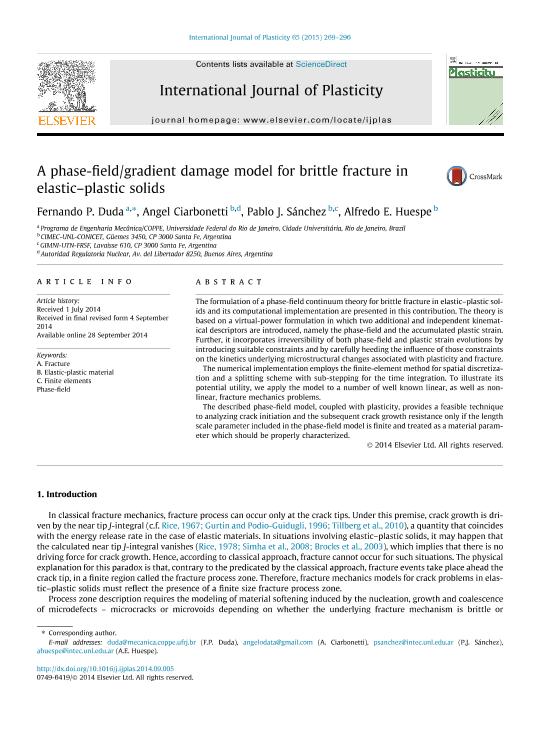Artículo
A phase-field gradient damage model of brittle fracture in elastic-plastic solids
Fecha de publicación:
02/2015
Editorial:
Elsevier
Revista:
International Journal of Plasticity
ISSN:
0749-6419
Idioma:
Inglés
Tipo de recurso:
Artículo publicado
Clasificación temática:
Resumen
The formulation of a phase-field continuum theory for brittle fracture in elastic–plastic solids and its computational implementation are presented in this contribution. The theory is based on a virtual-power formulation in which two additional and independent kinematical descriptors are introduced, namely the phase-field and the accumulated plastic strain. Further, it incorporates irreversibility of both phase-field and plastic strain evolutions by introducing suitable constraints and by carefully heeding the influence of those constraints on the kinetics underlying microstructural changes associated with plasticity and fracture. The numerical implementation employs the finite-element method for spatial discretization and a splitting scheme with sub-stepping for the time integration. To illustrate its potential utility, we apply the model to a number of well known linear, as well as nonlinear, fracture mechanics problems. The described phase-field model, coupled with plasticity, provides a feasible technique to analyzing crack initiation and the subsequent crack growth resistance only if the length scale parameter included in the phase-field model is finite and treated as a material parameter which should be properly characterized.
Palabras clave:
Fracture
,
Elasti-Plastic Material
,
Finite Elements
,
Phase-Field
Archivos asociados
Licencia
Identificadores
Colecciones
Articulos(CIMEC)
Articulos de CENTRO DE INVESTIGACION DE METODOS COMPUTACIONALES
Articulos de CENTRO DE INVESTIGACION DE METODOS COMPUTACIONALES
Citación
Duda, Fernando P.; Ciarbonetti, Angel; Sánchez, Pablo Javier; Huespe, Alfredo Edmundo; A phase-field gradient damage model of brittle fracture in elastic-plastic solids; Elsevier; International Journal of Plasticity; 65; 2-2015; 269-296
Compartir
Altmétricas




